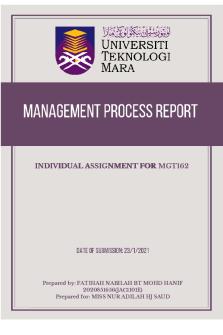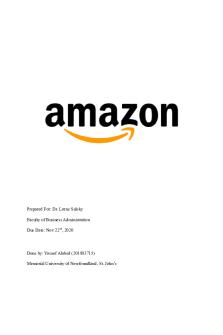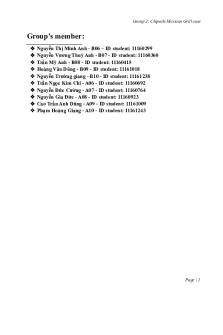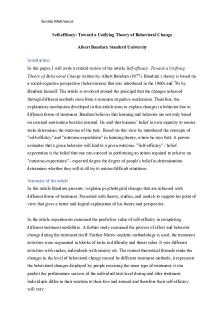MGT162- Individual Assignment PDF

| Title | MGT162- Individual Assignment |
|---|---|
| Author | parktaeah nabilah |
| Course | fundamental of management |
| Institution | Universiti Teknologi MARA |
| Pages | 17 |
| File Size | 1.4 MB |
| File Type | |
| Total Downloads | 236 |
| Total Views | 295 |
Summary
management process Report####### INDIVIDUAL ASSIGNMENT FOR MGTņŋŇPrepared by: FATIHAH NABILAH BT MOHD HANIF ŇŅŇŅ8ŊņŋŊŋŘJACņņŅņEř Prepared for: MISS NUR ADILAH HJ SAUDDATE OF SUBMISSION: 23/1/acknowledgementFirst of all, I would like to thank to Allah SWT because of His blessing it is possible for me...
Description
INDIVIDUAL ASSIGNMENT FOR MGT162
Prepared by: FATIHAH NABILAH BT MOHD HANIF 2020851656(JAC1101E) Prepared for: MISS NUR ADILAH HJ SAUD
TITLE
PAGE
1.0 BACKGROUND OF COMPANY
1
2.0 PLANNING 2.1 Vision & Mission Statement 2.2 Types of Planning 2.3 Types of Operational Plan
2 2 3 3
3.0 ORGANIZING 3.1 The Organizing Process 3.2 Organizational Structure
4 4 6
4.0 LEADING 4.1 Power
8 8
5.0 CONTROLLING 5.1 The Controlling Process 5.2 Types of Control
9 10 11
6.0 CONCLUSION & REFERENCES
13
The history of the H&M Group start from the company was founded by Erling Persson in 1947, when he opened his first shop in Västerås, Sweden. The shop, called Hennes (Swedish for "hers"), exclusively sold women's clothing. A store was opened in Norway in 1964. In 1968, Persson acquired the hunting apparel retailer Mauritz Widforss, which led to the inclusion of a menswear collection in the product range and the name change to Hennes & Mauritz. The company was listed on the Stockholm Stock Exchange in 1974. Shortly after, in 1976, the first store outside Scandinavia opened in London. H&M continued to expand in Europe and began to retail online in 1998 when bought the domain hm.com from a company called A1. The opening of its first U.S. store on 31 March 2000, on Fifth Avenue in New York City marked the start of the expansion outside of Europe.
In 2008, the company announced in a press release that it would begin selling home furnishings. Initially distributed through the company's online catalog, there are now H&M Home stores located internationally. Following expansion in Asia and the Middle East and the launch of concept stores including COS, Weekday, Monki, and Cheap Monday, in 2009 and 2010, branding consultancy Interbrand ranked the company as the twenty-first most-valuable global brand, making it the highest-ranked retailer in the survey. Its worth was estimated at $12–16 billion. H&M operated 2,325 stores at the end of 2011, and 2,629 stores at the end of August 2012. Its 3,000th store opened in September 2013 in Chengdu, China. In October 2020, H&M announced that they are planning to close 5% of their worldwide stores in 2021, as a result of the COVID-19 pandemic.
Page 1
The primary function of management is planning. Its aim is to ensure that human and economic resources are optimally used in business processes. It precedes the other business activities in an undertaking. It is the method of charting out the path to accomplish the ultimate purpose of business operations by outlining a reasonable degree of certainty. It not only includes anticipating the consequences of decisions but also forecasting events that can impact a company.
A vision statement is used to describe the future state of the organization. What the organization hopes to become in the future, for instance. It is, thus, a long-term goal that gives direction for the organization. In contrast to the mission, it outlines the current state of the organization and its main goals or objectives. It provides comprehensive information about what the organization does, how it does it, and for whom it does. The following are H&M Group's vision and mission statement:
i. H&M Group Vision
ii. H&M Group Mission
The H&M group’s vision for sustainability is to lead the change towards circular and climate positive fashion while being a fair and equal company. They work according to their ambitious sustainability strategy produced jointly with external and internal experts. Their sustainability work spans the entire value chain, focusing both on their own operations and, together with other stakeholders, the industry in general.
H&M mission statement is “to drive long-lasting positive change and improve living conditions by investing in people, communities and innovative ideas.” The statement emphasizes on the manner in which this company offers the world its fashions and designs. It comprises of the listed main parts: -Transforming shopping -Improving lives
The mission and vision statements are important and can best be represented as a guide and an organization's destination. Therefore, all organizations should create a clear vision and mission statement like U Mobile, as not doing so would be like going on a journey without knowing where to go.
Page 2
There are two types of planning, which are strategic planning and operational planning. For strategic planning, it is the process of creating specific business strategies, implementing them, and evaluating the results of executing the plan, regarding the overall 3 long-term goals or desires of a company. Three types of strategic planning are tactical plan, short-term plan and long-term plan. Three main strategic plan for H&M for the next five years would be linked with profitability, competition and technological leadership. H&M has reported a rise in sales and profits and sales every year. First plan is to maintain financial stability H&M has achieved. H&M plans to increase sales revenues. Secondly as main strategy of H&M is expansion, in competition is to increase number of stores by 10% to 15% every year. Today H&M has as 1840 stores up from 1618 at the same time last year. H&M is following all the latest innovations in the clothing manufacturing. It is important to increase efficiency, cut costs and keep prices low while raising quality. Third plan in the technological leadership for H&M is to lower maintenance costs by 15% and decrease waste by 10% till the year 2015.
Operational planning is a very comprehensive plan that gives a clear view of how a team, section or department will contribute to the achievement of the goals of the organization. There are two types of operational planning. First, standing plan. Standing plans are made to be used multiple times. The examples include policies for hiring, rules, employee interaction, procedures for reporting internal issues, or complaints to the HR department. Next, single-use plan. Single-use plans are also defined as 'specific plans' because their purpose is to solve a specific issue. Some examples are budgets, programes, projects and reports. For H&M Group, they have procedure or ways to collect personal information from their subscribers, which is one of their standing plans. The information is obtained directly through different methods and platforms. For example, when the cutomers use H&M Group Sites or Services through website, H&M Group’s own records of how the subscribers use Services or from third parties. Besides that, H&M Group also has rules for their employees. For example, they must follow the values and guidelines, as well as policies and manuals; of these, the Code of Ethics, the financial policy, the insider policy, the communications policy and the store instructions are examples of important overall policies. Awareness among the employees of the importance of maintaining the company's business.
Page 3
Organizing includes assigning tasks, dividing tasks into departments, delegating authority, and allocating resources over the organization. Managers need to coordinate employees, resources, policies, and processes during the organizing process to facilitate the goals defined in the plan. It is incredibly complex to organize and often includes a systematic review of human resources, priorities, and finances.
Organizing process includes aligning with the company’s mission and vision, determine task, duties and responsibilities, grouping into logical units and subunits, coordinating resources, monitoring and feedback. Firstly, H&M Group’s organizing process is aligning with the company’s mission and vision. This can be seen when H&M Group has enjoyed immense success in the market over the last few years and H&M has almost 4000 stores worldwide and has plans for 7000-8000 more stores in the future. This indicates that an increase in the number of costumers who are beginning to get to know the H&M brand including its loyal customer and trust in the brand and products is growing from strength to strength. Clearly, this is in line with H&M Group's vision. Other than that, H&M introduced a new website and mobile app equipped with capabilities that promise to improve the retail experience of shoppers both online and instore. Some of the new features include visual search, which allows users to search H&M’s catalog using images. There’s also Scan & Find, a feature that enables in-store customers to bring up additional product information. In line with these changes, H&M also introduced live chat, PayPal payments, and additional shipping options. These e-commerce and mobile enhancements seem to be paying off. In February 2019, H&M reported a 22% increase in online sales. Also, this shows that their organizing process is aligning with their mission too. Secondly, H&M Group also determines task, duties and responsibilities. For example, they have Chief Executive Officer (CEO), Karl-Johan Persson , who is responsible for making major corporate decisions, managing the general operations and resources of the company and many other responsibilities. Besides that, they have a Chief Financial Officer (CFO). The CFO, Jyrki Tervonen , duties include tracking cash flow and
Page 4
financial planning as well as analyzing the company's financial strengths and weaknesses and proposing corrective actions. Next is Chief Operating Officier (COO), Helena Helmersson who has responsibility for the functions Advanced Analytics & AI, Expansion, IT, Logistics, Production and Insights & Analytics. Other than that, they also have Chief Sales Officer (CSO) etc. Thirdly, also grouped into logical units and subunits. This can be seen when they have a marketing department. Marketing department is responsible for promoting the company's products, ideas, mission, and finding more customers. It arranges all marketing and advertising activities. Then, they have a finance department. In this department, they need to acquire funds for the company, managing funds and planning for the use of funds on different assets. Next, Human Resources are responsible for activities spanning a wide variety of core functions. In short, human resource activities fall under the following five core functions: staffing, development, compensation, safety and health, and employee and labor relations. They set standards for recruitment, implement training and support the development and growth of company's entire organization. All to ensure they have the right people with the right skills in the right positions – and at the right time. Fourthly, H&M Group also performs resource coordination. For example, they coordinate financial resources. Financial resources are active in tasks such as providing financial input for H&M corporate units and others for the annual Business Plan, preparation and loading budgets. Next, material resource. In the conduct of their business, H&M uses a range of physical assets. These assets mainly consist of office furniture, computers, mobile phones and other communication devices. Other than that, they also coordinate information resources. H&M uses data, articles, books and internal records that can be used to guide the planning, activities and evaluation of its operations. Lastly, H&M also does monitoring and feedback. The evidence is they perform regular system administration, maintenance and support of the Operation Support Systems Elements Management System to ensure that systems are consistently operating properly and are available for monitoring. Monitoring and feedback are important because it is to ensure that the organization is adapted to environmental and technological changes that are occurring in the organization.
Page 5
"There are six types of organizing structure, such as functional structure, product structure, customer structure, geographical structure, matrix structure and network structure. For H&M Group, they use the matrix structure which means that those responsible for the joint group functions are responsible for the efficiency of work within their function at each brand (the horizontal arrows). Each brand has its own organization and managing director, and all the brands have their own local sales organizations. Internal control is evaluated annually by the relevant group function, which checks that its function in each country is working according to the prescribed policies and guidelines. The stores are in turn checked by internal store auditors. When H&M Group uses a matrix structure, it allows cross-collaboration between staff and departments that may not always have opportunities to work together. There are several other key advantages for matrix organization structure which are collaboration between different departments, combines project and functional management structures, allows interdepartmental communication, employees can develop new skills and team members and managers keep their functional roles.
However, the matrix structure sometimes be difficult in achieving total structure in an environment where managers hold equal superiority over their shared team members. Additionally, team members might have misconceptions about how they are expected to divide their time between their functional duties and their project responsibilities. There can sometimes be several key disadvantages to using a matrix structure which are managerial roles may not be clearly defined, team roles may not be clearly defined, the decision-making process can be slowed down, too much work can cause overload, and measuring employee performance might become difficult.
Page 6
Based on the matrix structure, the Chief Executive Officer (CEO) is Karl-Johan Persson. Since he joined U Mobile in 2009, his leadership and strategic vision have made a difference in controling H&M Group's revenue development and market development to beat the industry average. As one of the world’s largest high street retailers, H&M Group has been thrust under the spotlight in recent industry debates surrounding the ethics and environmental consequences of fast fashion. But under Persson, H&M Group led the charge for high street fashion businesses to become more sustainable. Besides that, the Chief Financial Officer (CFO) of H&M Group is Jyrki Tervonen, who joined H&M Gruop in November 2008. Jyrki served as CFO, Finland and Country Manager, Finland, Poland, Czech Republic, Slovakia & Hungar for H&M. Apart from that, they have Chief Operating Officier (COO), Helena Helmersson. Helmersson graduated with a master's degree in international business administration at the Umeå School of Business and Economics in 1997. On joining H&M in 1997, she became a section manager in the buying office before she went to Dhaka, Bangladesh in 2007 where she was H&M's production manager. After a further period serving as their department manager for underwear production in Hong Kong until 2010 when she returned to Stockholm to be manager for social responsibility and supply. She was appointed as COO in September 2018.
Page 7
Leading is the use of influence to motivate employees to fulfil organizational goals. As a manager, he or she should be able to make employees eager to participate in achieving the goals of an organization. Leading by example makes most individuals see what is ahead and act efficiently along the way to counter any obstacles. If a organization is headed by a person with great leadership skills, it will help the organization move toward goal attainment.
Power can be defined as the dominance that someone has over another. It refers to the ability to accomplish a goal with the assistance of others. There are 2 types of power. Firstly, position power. It includes legitimate power, coercive power, reward power and information power. Secondly, personal power. Examples of personal power include expert power and referent power.
i. Position Power For position power of H&M Group, they have legitimate power. In an organization, legitimate power comes from holding a position of power, such as being the boss or a central member of a leadership committee. For example, H&M has a Chief Executive Officer (CEO), Karl-Johan Persson, who is known as the highest-ranking officer in the company and responsible for taking managerial decisions, managing the general operations and resources of the company and many other responsibilities. Other than legitimate power, H&M also has information power. Information power is a type of power focused on controlling the information that other people need in order to accomplish a goal. For example, the CEO Karl-Johan Persson provided information on among othert hings the strategic plan and goals in response to the great transition that is taking place in the industry as well as the climate change that is affecting us all. Matters such as the customer offering and the status ofeach brand, digital development, sustainability, optimising the store portfolio along with future store development and the integration of stores and online.
Page 8
ii. Personal Power For personal power of H&M Group, they have referent power. Referent power is obtained by the interaction between the individual exercising power and any icon that literally exercises power and influence. For example, their Chief Executive Officer (CEO), Karl-Johan Persson was admired because of his great decision, such as after the 2011 Rana Plaza factory collapse killed more than 1,100 garment workers, Persson launched a fair living wage initiative that promised to affect around 850,000 Bangladeshi workers. He leads the company’s sustainability plan which includes a fair living wage initiative. Under the initiative, H&M’s vision is to ensure that all textile workers are able to live on their wage, including an initial focus on the company’s own strategic suppliers. The goal is to ensure that all suppliers have improved pay structures for fair living wages in place by 2018, affecting around 850,000 textile workers. But under Persson, H&M Group led the charge for high street fashion businesses to become more sustainable.
Controlling is one of the important roles of a manager. A manager should exercise effective control over subordinate activities to obtain planned outcomes from subordinates. In other words, it is possible to interpret the meaning of the role of control as ensuring that activities are performed in the organization as planned. Controlling also means that organizational resources are used effectively and efficiently to achieve a predetermined goal.
Page 9
i. Setting Standards for Performance The first step in the control process is to set performance standards. These standards are the basis for measuring the actual performance. It includes making decisions over a period of time on the goals that an organization needs to focus on. These can be production, customer satisfaction, financial or employee performance-related goals. Also, the standards must be attainable, measurable, and clear. For H&M Group, their standards for performance are lead the change towards a circular and renewable fashion industry, while being a fair and equal company. So, the manager should aim to set these standards in quantitative terms as far as possible in order to allow easy comparison of actual performance with the standards. In the case of qualitative standards, however, efforts should be taken to define these standards in such a way that comparisons can clearly be interpreted. Using their size and scale, they are working to catalyse these systemic changes across their own operations and the wider industry to ensure that they can continue to create great fashion and design in a sustainable way for many generations to come.
i. Measuring Actual Performance This includes the creation of measurement tools for data collection. This tool should be able to report performance as it relates to set standards, or steps, set in...
Similar Free PDFs

MGT162- Individual Assignment
- 17 Pages

Individual ASSG MGT162 ( Munchy\'S)
- 13 Pages

Assignment MGT162 - THANK YOU
- 16 Pages

Individual Assignment
- 26 Pages

Individual Assignment
- 20 Pages

Individual assignment
- 5 Pages

Individual assignment
- 3 Pages
Popular Institutions
- Tinajero National High School - Annex
- Politeknik Caltex Riau
- Yokohama City University
- SGT University
- University of Al-Qadisiyah
- Divine Word College of Vigan
- Techniek College Rotterdam
- Universidade de Santiago
- Universiti Teknologi MARA Cawangan Johor Kampus Pasir Gudang
- Poltekkes Kemenkes Yogyakarta
- Baguio City National High School
- Colegio san marcos
- preparatoria uno
- Centro de Bachillerato Tecnológico Industrial y de Servicios No. 107
- Dalian Maritime University
- Quang Trung Secondary School
- Colegio Tecnológico en Informática
- Corporación Regional de Educación Superior
- Grupo CEDVA
- Dar Al Uloom University
- Centro de Estudios Preuniversitarios de la Universidad Nacional de Ingeniería
- 上智大学
- Aakash International School, Nuna Majara
- San Felipe Neri Catholic School
- Kang Chiao International School - New Taipei City
- Misamis Occidental National High School
- Institución Educativa Escuela Normal Juan Ladrilleros
- Kolehiyo ng Pantukan
- Batanes State College
- Instituto Continental
- Sekolah Menengah Kejuruan Kesehatan Kaltara (Tarakan)
- Colegio de La Inmaculada Concepcion - Cebu








